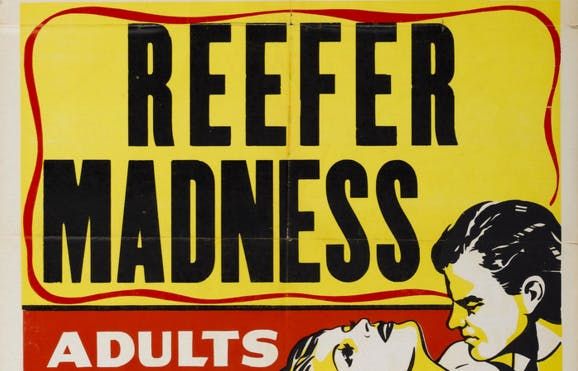The history of marijuana propaganda follows an interesting trajectory,
from moral outrage to a seemingly objective and measured scientific
censure. In the arguments, certain themes and tropes appear again and
again, as the narrative has built on its own stories, refined its
approach and responded to criticisms.
Reefer Madness
This 1936 film depicts
the anti-marijuana propaganda movement in its first frenzied iteration.
The narrative follows the plight of a young man who smokes the "vicious
weed" and finds himself plunged in short order into a nightmare of
violence and murder that culminates in suicide and insanity. In the
1930s, cannabis and hemp, which had been grown for hundreds of years in
the US, even by the founding fathers, began being referred to as
"marijuana," perhaps to associate it more closely with Mexican
immigrants, who were accused of taking American jobs during the
Depression.
Marijuana, Assassin of Youth
This 1937 screed was
penned by H.F. Anslinger, U.S. Commissioner of Narcotics, together with
Courtney Ryley Cooper. Published in the American Magazine, the article
could easily be a synopsis of "Reefer Madness," suggesting that the
Narcotics Czar didn’t look too far for his inspiration. Its notable
theme is marijuana’s unpredictable quality, presumably responding to
people who had tried the plant and discovered it to be quite benign. One
never knew how the brain would react, and "whether he will become a
philosopher, a joyous reveler, a mad insensate or a murderer." This work
contained a potent theme that would appear again and again in the annals
of drug prohibition literature: of young people, completely detached
from material reality, flinging themselves from windows to their death.
Marihuana — The Evil Weed
Published in Detective World in 1947 and written by Judge Carl F.
Dieffenbach, Jr, this
article built on the
assassin theme and began to associate the plant with everything foreign
and strange to the American mind. The notable use of the Anglicized
spelling variation — with "h" replacing "j" — was very likely a
deliberate choice to make the plant sound more unAmerican and menacing.
Hinting that "hashish" is related to the Arabic word "assassin," the
article depicts the plant as a snake that originated in the Orient and
traveled through Mexico, then wound itself in a serpentine fashion
through the social world of American life, determined to destroy not
just the mind but also our collective culture. The article goes on to
indulge in blatantly racist insinuations, associating "reefers" with
"jazz" halls and "juke joints." In this reprehensible but masterly
example of period propaganda, even the poet Homer is evoked to denounce
the deadly plant, which had apparently invested the ancient Persians
with their devilish power.
Dare Smokes a Reefer
Published in 1953, Dare
Magazine
concocted a scary composite picture of drug users turned into criminals
and murderers from smoking "reefers." Beyond these cautionary tales, the
reader was told that nearly all heroin and cocaine users started with
marijuana, and only graduated to harder drugs when the thrill wore off,
establishing marijuana as a "gateway" drug to harder stuff. One
consequence of marijuana depicted in these case studies is tied back to
its very illegality. This circular reasoning — marijuana users suffer
when they get arrested for possessing it — became very popular in
future messaging.
The Surgeon General’s Warning on Marijuana
By 1982, the
story had
changed quite a bit. Marijuana was linked to "amotivational syndrome,"
characterized by low energy, diminished performance and lack of drive —
almost exactly the opposite of the manic, super-human claims of the
previous decades. Along with these effects, the literature warned of low
sperm count, cancer and an impaired immune system.
Marijuana — National Drug Threat Assessment
This official
report,
published as recently as 2003, positioned marijuana as the leading drug
threat to the country. It focused heavily on crime reports in framing
the argument, which was heavily skewed to the perceptions of law
enforcement agencies. Again, this problem arises from the fact that
marijuana is illegal. It suggested that marijuana might be physically
addictive and posited that decriminalization would increase usage.
Today, marijuana still tops the federal list of dangerous and addictive
drugs. Since 1970, cannabis has been classified as a schedule I
prohibited substance, the most restrictive category. However, there are
signals coming from the DEA that changes may be coming soon. Maybe it’s
time to hear the other side of the story.



